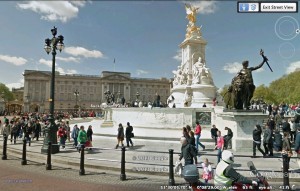@RachaelS_dtc
Before mechanical reproduction, such as photography, a historical object would have reverence because of its worth and uniqueness. Now, we have advanced technology that allows us to reproduce historical objects. In Walter Benjamin’s article, “The Work of Art in the Age of Mechanical Reproduction,” he says that the aura of art is being destroyed through reproduction. The image above, from Google Earth, shows the street in front of Buckingham Palace in the United Kingdom. Since this picture is a reproduction, Benjamin would say that it lacks one element: “its presence in time and space” (3). Having a unique existence would give this picture authenticity and history. Of course this image has neither of these because it is a replica of the actual object: Buckingham Palace. The aura of Buckingham Palace, or the reverence toward it, decays in this photo because it is not the actual object. Instead, the aura created is fake, or kitsch. Aura decays when the object is reproduced such as through a photo. Benjamin says this is true because “reproduction as offered by picture magazines and newsreels differs from the image seen by the unarmed eye” (4). Benjamin also says that the uniqueness of art is its aura. So, as an object is reproduced, it is no longer unique and the aura decays. Many pictures of Buckingham Palace can be recreated through mechanical reproduction, including the image above. Every photo created is a form of mechanical reproduction and is not authentic. Benjamin explains this with the example of photographic negatives, saying “to ask for the ‘authentic’ print makes no sense” (5). With mechanical reproduction, authenticity and the aura in art deteriorates.

